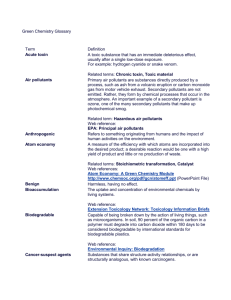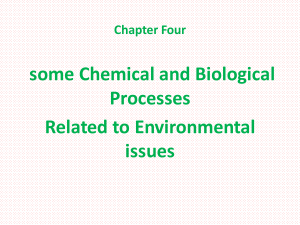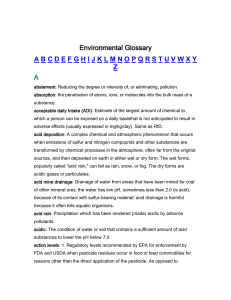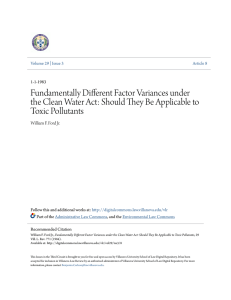Master Course Outline ENVS& 100 Survey of Environmental Science
advertisement
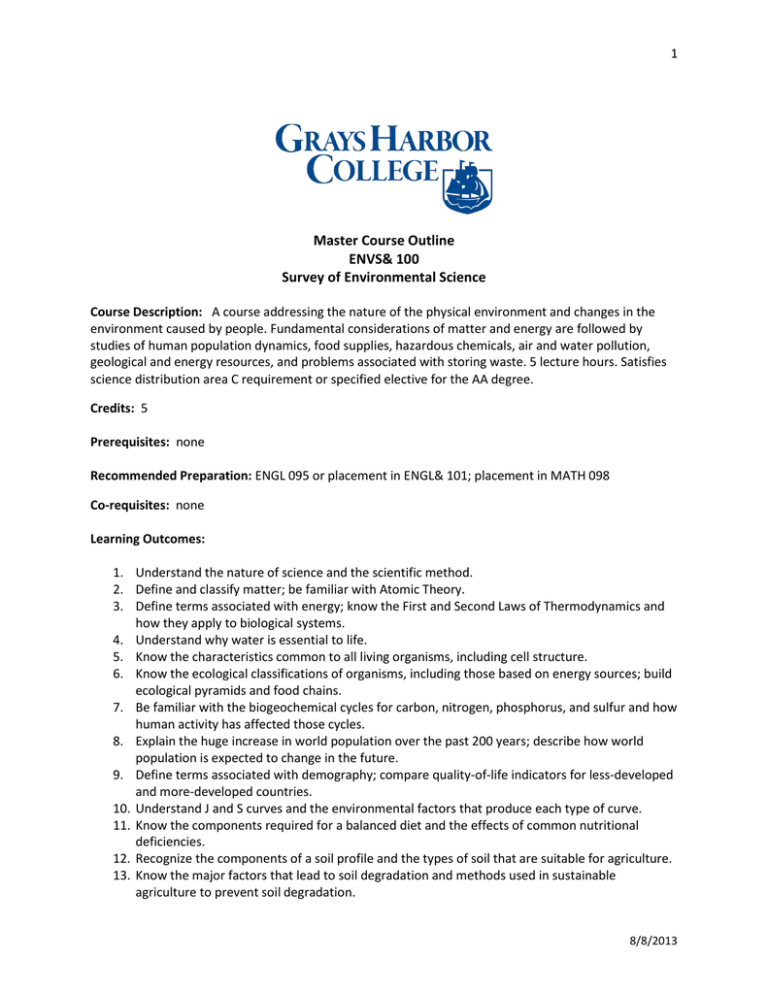
1 Master Course Outline ENVS& 100 Survey of Environmental Science Course Description: A course addressing the nature of the physical environment and changes in the environment caused by people. Fundamental considerations of matter and energy are followed by studies of human population dynamics, food supplies, hazardous chemicals, air and water pollution, geological and energy resources, and problems associated with storing waste. 5 lecture hours. Satisfies science distribution area C requirement or specified elective for the AA degree. Credits: 5 Prerequisites: none Recommended Preparation: ENGL 095 or placement in ENGL& 101; placement in MATH 098 Co-requisites: none Learning Outcomes: 1. Understand the nature of science and the scientific method. 2. Define and classify matter; be familiar with Atomic Theory. 3. Define terms associated with energy; know the First and Second Laws of Thermodynamics and how they apply to biological systems. 4. Understand why water is essential to life. 5. Know the characteristics common to all living organisms, including cell structure. 6. Know the ecological classifications of organisms, including those based on energy sources; build ecological pyramids and food chains. 7. Be familiar with the biogeochemical cycles for carbon, nitrogen, phosphorus, and sulfur and how human activity has affected those cycles. 8. Explain the huge increase in world population over the past 200 years; describe how world population is expected to change in the future. 9. Define terms associated with demography; compare quality-of-life indicators for less-developed and more-developed countries. 10. Understand J and S curves and the environmental factors that produce each type of curve. 11. Know the components required for a balanced diet and the effects of common nutritional deficiencies. 12. Recognize the components of a soil profile and the types of soil that are suitable for agriculture. 13. Know the major factors that lead to soil degradation and methods used in sustainable agriculture to prevent soil degradation. 8/8/2013 2 14. Describe the effects of the overuse of synthetic fertilizers and pesticides and methods to reduce their use. 15. Understand the effects of the Green Revolution on agriculture. 16. Understand how genetic engineering is being used to improve crop varieties and the advantages and disadvantages of growing genetically modified organisms. 17. Know the leading causes of global disease burden. 18. Classify hazardous and toxic chemicals. 19. Understand the factors involved in the movement of toxic chemicals throughout the environment, including bioaccumulation and biomagnification. 20. Understand the factors that affect the sensitivity of an individual to toxic chemicals. 21. Understand how the dose/response curve for a toxic chemical is determined and how risk is assessed and managed. 22. Understand the structure of the atmosphere and what happens to radiation as it passes through the atmosphere, including the Greenhouse Effect. 23. Understand how increasing levels of carbon dioxide and methane in the atmosphere produce global climate change; describe evidence that indicates global warming is occurring; understand the goals of the Kyoto Protocol and methods that can be used to reach these goals. 24. Know the human sources, health effects, and methods for reducing the production of the seven conventional air pollutants; describe the effects of the Clean Air Act on the levels of emissions of these pollutants. 25. Understand the role of chlorofluorocarbons in depleting ozone levels in the stratosphere and how the Montreal Protocol has addressed this issue. 26. Know how water is distributed throughout the world and how fresh water can be made available year-round. 27. Know the health effects of common biological and chemical water pollutants, including both inorganic and organic pollutants, and the effects of the Clear Water Act on the levels of these pollutants in water supplies. 28. Understand how oxygen-demanding waste and plant nutrients affect the dissolved oxygen content and biochemical oxygen demand in aquatic ecosystems, including eutrophication. 29. Describe how septic tanks and municipal sewage treatment plants operate and the advantages and disadvantages of each. 30. Describe the major sources and uses of energy both in the world and in the United States. 31. Describe the advantages and disadvantages of using fossil fuels, nuclear power, and hydropower as energy sources; understand the design and operation of nuclear power plants. 32. Describe ways in which energy can be conserved. 33. Describe the advantages and disadvantages of alternate energy sources. 34. Know the major components of the waste stream and methods of reducing waste. 35. Describe the problems associated with waste disposal, including the disposal of e-waste and hazardous waste. 36. Know the goals of the Superfund Act and the problems associated with administering the act. Course Resources/Textbooks/Website: Principles of Environmental Science, 5th and/or 6th Edition, William P. and Mary Ann Cunningham, McGraw Hill, 2009/2011, http://catalogs.mhhe.com/mhhe/viewProductDetails.do?isbn=0073383244 Academic Integrity: All forms of cheating, falsification, and plagiarism are against the rules of this course and of Grays Harbor College. Students who are unsure what constitutes academic dishonesty are 8/8/2013 3 responsible for asking the instructor for clarification. Instances of intentional academic dishonesty will be dealt with severely. Disabilities: Students who have documented disabilities that require accommodations in compliance with the Americans with Disabilities Act should contact the Disability Support Services coordinator as well as the instructor of the course in order to ensure that together we create an optimal environment for educational achievement. W Day: W Day, the final day to officially withdraw from a course, is the Thursday of the seventh week (Thursday of the fourth week for summer quarter). Students who do not withdraw by that date will receive the grades they have earned, regardless of whether they are attending the course or completing the work. Students who are considering withdrawal are strongly advised to consult with the instructor, advisor and financial aid prior to withdrawing. The only withdrawals allowed after W Day are complete withdrawals from all courses. 8/8/2013


